The Huawei Honor 5X Review: Mid-Range Meets Maturity
by Brandon Chester on February 29, 2016 8:00 AM EST- Posted in
- Smartphones
- Huawei
- Android
- Snapdragon 616
- Honor 5X
Display Analysis
With each year we've seen the displays on smartphones get better and better. It really wasn't that long ago that we saw the first 720p panels on flagship smartphones, and now we're at the point where a $200 mid range phone can ship with a 1080p IPS display. In the case of the Honor 5X it's a 5.5" 1920x1080 IPS LCD panel. Like most phones, the LCD is optically bonded to the cover glass.
Something I'm definitely going to have to keep an eye on going forward is whether or not these mid range phones with IPS displays actually have a native 8-bit per channel color depth. Because of modern Android's relative lack of gradients I haven't bothered doing so, as you don't really see any issues cropping up. However, the Honor 5X has many gradients, especially in the areas where translucency is used in the UI, and it's fairly obvious that there's color banding occurring.
It's difficult to capture this in a photo, but I think the above photo is able to demonstrate the effect fairly well. I suspect that many of these mid range phones are using IPS displays with 6-bit color and frame rate control to simulate a greater color depth, and there simply aren't enough discrete color levels to properly render the gradients. It's not a deal breaker or anything, but it definitely takes away from the aesthetic quality of translucency, and it's something I'll be looking for more closely going forward.
A display can be measured in several ways beyond simply comparing resolution and pixel density, and to examine the Honor 5X's display in a comprehensive manner I've sent it through our standard smartphone display workflow. As always, measurements are performed with an X-Rite i1Pro 2 spectrophotometer, with the exception of contrast measurements which are done with an i1Display Pro colorimeter. All data is collected and managed using SpectraCal's CalMAN 5 software.
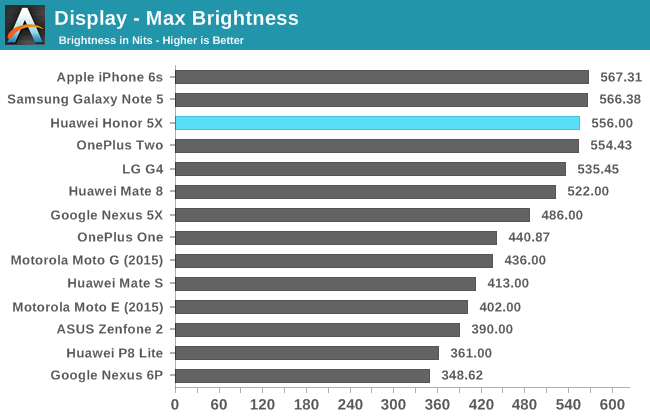
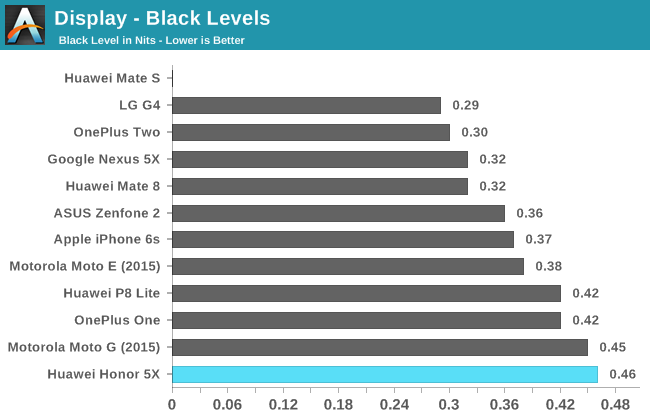
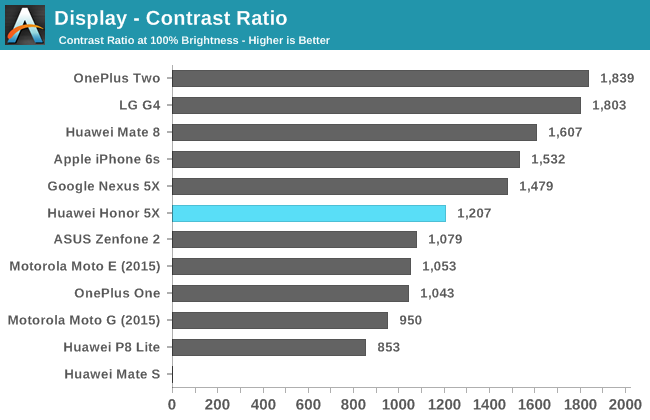
I was honestly quite surprised by the Honor 5X's high peak brightness. 556 nits places it among the best flagship phones, and the black level at max brightness leads to a static contrast ratio of 1207:1, which I've confirmed is not the result of any backlight trickery. Low contrast has definitely been an issue with other mid range and low end smartphones, and I'm happy to say that the Honor 5X doesn't disappoint. The only caveat is that Huawei is still employing their brightness reduction when you use Google Chrome, and the drop is pretty massive as well. It's not even done in a subtle manner either, as the brightness just plummets when you open the browser. I think users should have the option to make the brightness vs. battery life tradeoff, even if that means sacrificing quite a bit of the latter for a brighter screen, and I hope this auto reduction eventually disappears from Huawei's phones.

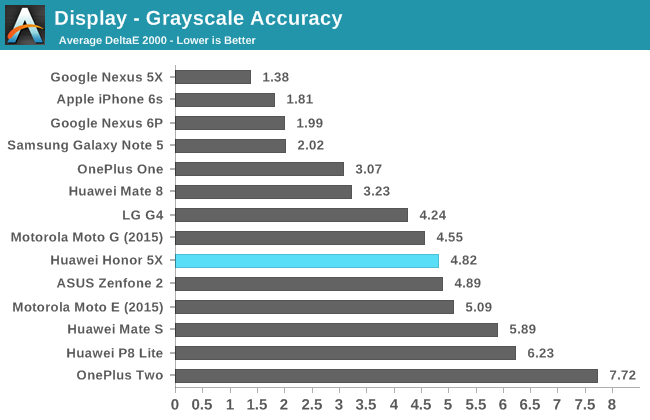
Greyscale accuracy on the Honor 5X isn't horrible by any means, but it's not very accurate either. The DeltaE value is in the same range as other mid range smartphones like the Moto E, Moto G, and Zenfone 2. Calibration hasn't really trickled down from high end smartphones yet, except in the strange case of some Microsoft Lumia smartphones. In this case, the display exhibits a noticeable blue shift which reduces accuracy.
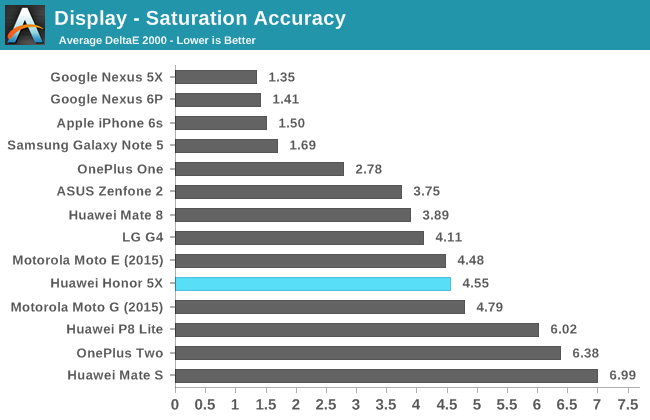
Saturation accuracy is similar to greyscale accuracy on the Honor 5X, and for the same reason too. As you can see, all colors are pulled toward blue to some degree which causes them to render differently than they should. Again, this error is in line with other mid range phones, so it's not like Huawei is behind the competition here, but they're not exactly raising the bar either.
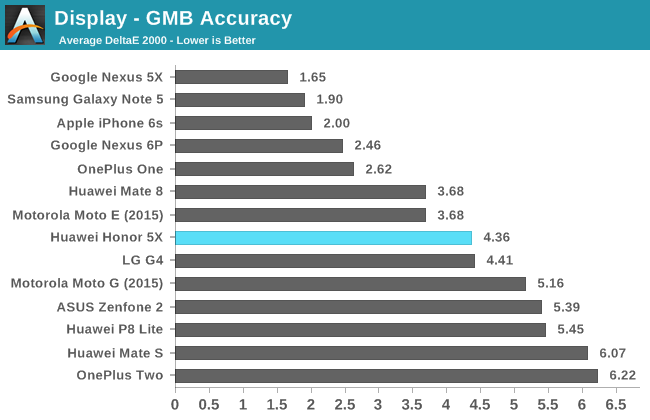
Accuracy in the Gretag-MacBeth ColorChecker is also similar to saturation and greyscale accuracy, which isn't surprising when one considers how the test actually includes greyscale values and the fact that color mixtures require both greyscale shades and saturations to be accurate in order to render correctly.
In the end, the Honor 5X's display is above average relative to its price. It's a 1080p panel with a very high brightness and good black levels as well. Color accuracy isn't any better than the competition, but the competition is also mostly made up of 1280x720 panels that are 100 nits dimmer at full brightness, so it's fair to say that Huawei has done a good job with the Honor 5X's display given their constraints. I think the sort of user who buys the Honor 5X probably won't be bothered by the color inaccuracy anyway, although I do still hope to see higher accuracy trickle down from the flagships to the mid range market within the next year as it becomes more difficult to differentiate on hardware and price.


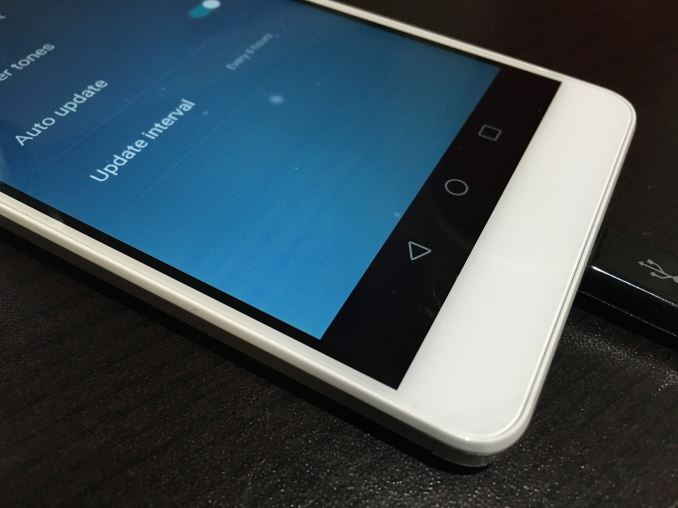
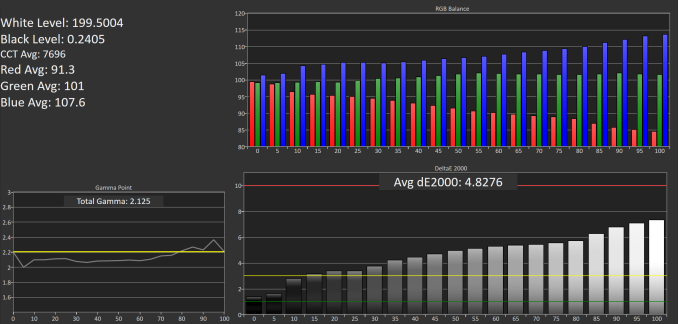

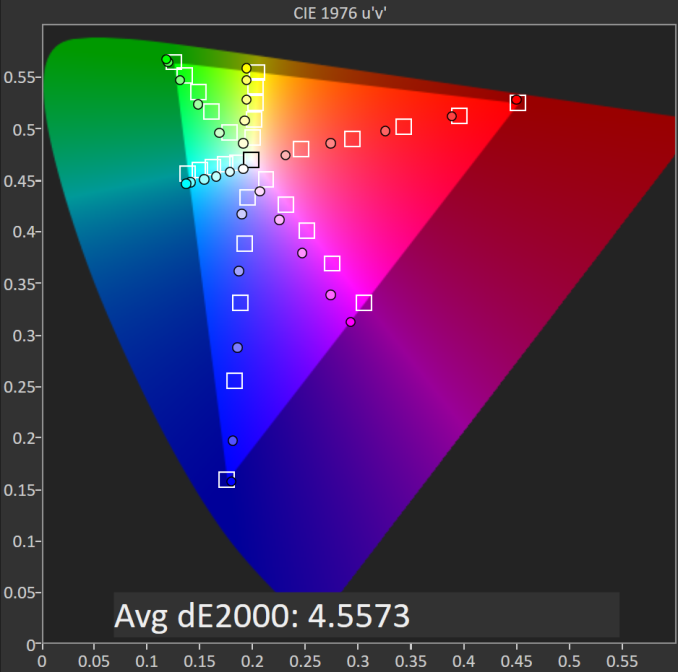










30 Comments
View All Comments
UtilityMax - Thursday, March 3, 2016 - link
Indeed. If the device is mid-range, shouldn't it be at least competitive with a three year old flagship SoC, such as the Snapdragon 800? Looking at the benchmarks, SD800 is still much faster at least in single threaded benchmarks. But the market "has spoken". We "need" 64-bit and eight cores they said..LiverpoolFC5903 - Tuesday, March 1, 2016 - link
I'd like to see the A53s clocked much higher (2.2-2.5 ghz) in mid range chipsets to make it competitive with previous gen Snapdragon 800 socs. SIngle threaded performance is still very critical in terms of javascript performance. A high clocked A53 based soc with dual channel RAM and a decent GPU is more than enough for most applications.UtilityMax - Thursday, March 3, 2016 - link
My thought too. Come on people. The Snapdragon 800 is three years old. Can't we have that level of performance in at least in a midrange smartphone these days? Instead, we see "midrange" devices with SoC performance that's about on the level with the original iPhone 5.LiverpoolFC5903 - Thursday, March 3, 2016 - link
Last years 'mid range' Qualcomm chipsets were laughably underpowered. Hell , my 3 year old Optimus G Pro with a 1.7ghz Snapdragon 600 and Adreno 320 2nd gen GPU is STILL faster than Snapdragon 615 phones. Dual channel memory and GPU makes a LOT of difference to the overall 'feel' and usability of a smartphone. And obviously single threaded performance, which is very important in day to day user experience, needs to be at least at the Snapdragon 800/801 range in 2016.zodiacfml - Sunday, March 6, 2016 - link
Right. There are some phones still available with those chips previous the 810 for a near mid-range price.mmsmsy - Tuesday, March 1, 2016 - link
How about Xiaomi Redmi Note 3 with Mediatek X10 or the Pro version with Snapdragon 650? In my opinion way more important phone to review that this one.LiverpoolFC5903 - Tuesday, March 1, 2016 - link
I dont believe Anandtech have done a review of ANY phone with the Helio X10. Would love to see a detailed analysis of that chipset, especially compared to erstwhile flagship socs from the 800 series.Badelhas - Tuesday, March 1, 2016 - link
True.But what I really want to see is AnandTech reviewing the HTC VIVE! :)
Ryan Smith - Tuesday, March 1, 2016 - link
It's on my list of things I want to do.=)LukaP - Tuesday, March 1, 2016 - link
Hell the Mi4c is only a bit more expensive than this, and offers a S808 and otherwise pretty high end specs... This is a decisively lowend device.